Weeds and Weeding 2 - General Weeding
Ongoing weeding tasks - see here for tips on how to clear areas of perennial weeds.
Like so much else in gardening, the secret of keeping the weeds down is little and often. Turn your back on them for any length of time and the perennials get their roots down deep and the annuals have produced seeds by the thousand to ensure that you've got them for the next few years too
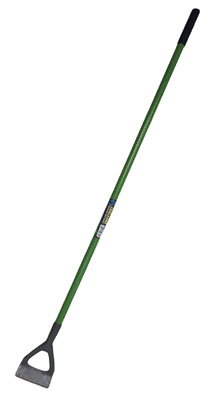
![]() Top tip no.1 - Don't give yourself a large expanse of
soil to keep weed free. The old-fashioned "rod for
your own back" school of gardening requires that plants are
separated from each other by large expanses of bare soil - well
nature abhors a vacuum and will readily provide many contenders
to fill it. So continuous planting schemes and the use of mulches,
weed suppressant fabric, gravel or the like will make your
life a lot easier.
Top tip no.1 - Don't give yourself a large expanse of
soil to keep weed free. The old-fashioned "rod for
your own back" school of gardening requires that plants are
separated from each other by large expanses of bare soil - well
nature abhors a vacuum and will readily provide many contenders
to fill it. So continuous planting schemes and the use of mulches,
weed suppressant fabric, gravel or the like will make your
life a lot easier.
![]() Top tip no.2 - Get a decent hoe, use it
often and also sharpen it every now and then. A traditional
pattern Dutch hoe is the best in my opinion. There is an almost
endless succession of "easy weeder" type products that are supposed
to make weeding so much easier that it's a positive joy. Like
ironing, weeding will never be a positive joy and the latest
gadget is not going to change that. Hold the hoe so that the
flat of the blade is close to horizontal and slide it back and
forth on or just under the surface of the soil.
Top tip no.2 - Get a decent hoe, use it
often and also sharpen it every now and then. A traditional
pattern Dutch hoe is the best in my opinion. There is an almost
endless succession of "easy weeder" type products that are supposed
to make weeding so much easier that it's a positive joy. Like
ironing, weeding will never be a positive joy and the latest
gadget is not going to change that. Hold the hoe so that the
flat of the blade is close to horizontal and slide it back and
forth on or just under the surface of the soil.
It's often better to use the larger tool in the garden, so a full length hoe instead of a small hand-tool, a spade instead of a trowel. There are two reasons for this, first that people tend to "under-garden" - they try to get away with doing too little - the larger tool does more by definition. Secondly, the larger tool is usually used standing up rather than kneeling or bending and it uses the bigger muscles in the upper arm and shoulders rather than forearm, wrist and hands - these muscles are stronger and can do more work more easily, so the job is easier.
The job of the hoe is to sever the top growth of weeds from the roots, so the sharper it is the better it can do this job. It will go blunt in use of course, but can easily be sharpened up again. It will also probably be blunt when you buy it.
Hoeing is best done in the morning if possible and ideally when the soil is dry on the surface. If the soil is too wet, the hoe ends up pulling some weeds up and re-planting them elsewhere, the moisture helping them survive. If it is done early in the day, there's more chance that the weeds will dry out in the sun and be killed, hoeing wet soil is much harder work too.
Hoeing is best carried out around established plants as the roots are deeper than younger, smaller plants.
Paths, patios and drives
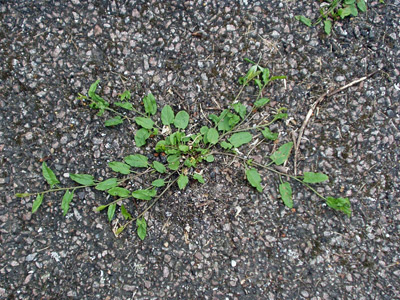 First
of all don't make life difficult. For patios and drives,
make sure there is enough depth of compacted hardcore (about
4") and that the slabs or setts are bedded on a mortar mix rather
than just sand and then pointed after being laid with a mortar
mix rather than just sand. For gravel areas, a couple of inches
above a weed-proof membrane or above an equal amount of compacted
hardcore. Compacted hardcore with shallower gravel is best if
the surface is to be walked or driven on. Don't just lay gravel
onto the soil and hope it will do - it won't. In time weeds
will take hold and when you try to pull them up, you'll mix
soil with the gravel - the result will look awful and it will
be a nightmare to sort out again.
First
of all don't make life difficult. For patios and drives,
make sure there is enough depth of compacted hardcore (about
4") and that the slabs or setts are bedded on a mortar mix rather
than just sand and then pointed after being laid with a mortar
mix rather than just sand. For gravel areas, a couple of inches
above a weed-proof membrane or above an equal amount of compacted
hardcore. Compacted hardcore with shallower gravel is best if
the surface is to be walked or driven on. Don't just lay gravel
onto the soil and hope it will do - it won't. In time weeds
will take hold and when you try to pull them up, you'll mix
soil with the gravel - the result will look awful and it will
be a nightmare to sort out again.
There are various ways of getting rid of weeds from in between cracks or that have pushed through the tarmac of a driveway. Hoeing isn't possible and just removing top growth won't work unless you keep on doing it every few days which could be a major chore if the area is large - it's also near impossible to reach the roots.
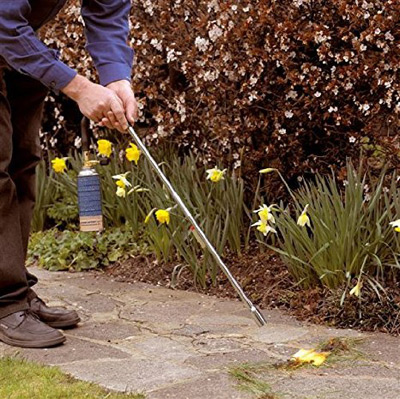 Gas
weeders are an effective way of dealing with weeds in paving
and paths. They can be small hand-held models, or larger
ones that can be trundled around on wheels that may also have
a hood covering the flame so increasing effectiveness. The idea
is that the gun is used to shrivel and kill the weed rather
than reducing it to a crisp or vapourizing it.
Gas
weeders are an effective way of dealing with weeds in paving
and paths. They can be small hand-held models, or larger
ones that can be trundled around on wheels that may also have
a hood covering the flame so increasing effectiveness. The idea
is that the gun is used to shrivel and kill the weed rather
than reducing it to a crisp or vapourizing it.
For smaller amounts of weeds hot water can be used in the same way, out of a kettle to mortally wound and then be left for a few days before removing it completely.
For the less organically inclined, path weed killer is the easiest way to go. DON'T USE IT ELSEWHERE PARTICULARLY ON THE LAWN.
I have received many emails that say something like "My grass has all died because I applied path weed killer - what can I do?". Well the reason it is path weed killer specifically is that it is long lasting and residual and kills everything. Lawn weed killers specifically only attack broad leaved plants (dicotyledons) and leave narrow leaved grasses (monocotyledons) unharmed. Other general weed killers kill plants on contact and are neutralised by the soil, they have no lasting residual effect. So make sure you know what you have and use it appropriately. The answer if it is applied to the lawn? - wait at least 6 months and then re-sow or turf the area, any sooner and the weed killer in the ground will kill the new stuff too.
Application of chemical weed killers
This can be done using a watering can and a spray-bar or fine rose, I'm not keen on this method as it uses far too much of the chemical far too quickly, this is not good for the environment - even if you're not completely organic, as little chemical as possible should be used - and it is expensive too.
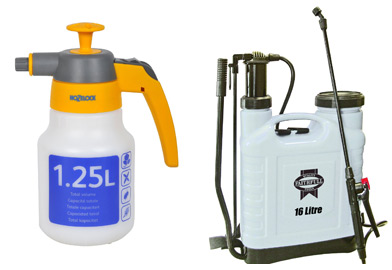 I
prefer a pressure sprayer for applying garden chemicals.
I have a 1 litre model where I pump away at the compressor and
then use the trigger to release the liquid. This is much more
economical on chemicals and much easier than
the types where you squeeze away on the trigger like a water
pistol to squirt the chemical out, unless you have forearm muscles
that can crack billiard balls.
I
prefer a pressure sprayer for applying garden chemicals.
I have a 1 litre model where I pump away at the compressor and
then use the trigger to release the liquid. This is much more
economical on chemicals and much easier than
the types where you squeeze away on the trigger like a water
pistol to squirt the chemical out, unless you have forearm muscles
that can crack billiard balls.
Make sure you wash them out thoroughly after use and before storage, never store them with a chemical in. Most garden chemicals lose their intended effectiveness after a few days when diluted anyhow - this doesn't stop them continuing to be poisonous though! and you won't necessarily remember what is in it from last time you used it.
My 1 litre model is enough for me to completely dose a small to medium-sized tree with pesticide and I have never felt the need to get a larger model. Certainly I would be surprised if anything larger than a 5 liter model was needed for a small to medium sized garden. Much bigger models are available with back-packs and trolleys, but I also feel that because the capacity is greater, there will be a greater temptation to use them to pump out even more chemicals into the environment. Like going on holiday with a bigger suitcase, however big it is you always fill it, get a smaller one and use less.
Dealing with the pulled up weeds
This can be a bit of a problem when hand-weeding perennial weeds and having dug up your tornado-proof, phoenix-like foe, putting it on the compost heap can be a bit like sending it on a holiday to build up its strength and recover again. Don't compost perennial weed roots unless you are certain you can kill them. One way of doing this is to put them to one side in a separate bucket or container. I have successfully cooked tough old ground elder roots by burying them in the center of a ball of grass clippings in the compost heap. Each time I mowed the lawn, I got rid of a part of the root pile. The rotting grass ensured that the temperature got high enough to kill off what are notoriously tough weed roots.
Alternatively, you could have some kind of bucket or barrel of water and just drown them for a few weeks, weight them down so they don't get any oxygen from the surface. Tip them out on the compost heap when they're good and dead.
 Glyphosate
weedkiller
Glyphosate
weedkiller
For leafy weeds - A systemic
weedkiller that gets taken up by the leaves and carried to all parts.
Neutralised on contact with the soil, so not a persistent weedkiller
meaning that you can plant into the soil once the weeds have been killed
and removed. Best used during active growth on weeds with plenty of
leaf area to take it up.
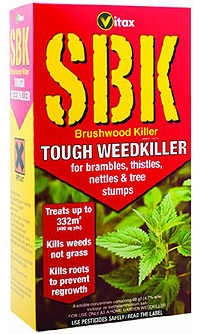 Brushwood
killer
Brushwood
killer
For tough woody weeds such as briars,
brambles, nettles, dock, tree saplings and tree stumps amongst others.
Selective broad-leaf weedkiller so will not harm grass, use in spring
and summer, usually requires around 6 weeks between use and re-planting
of braodleaved plants with the area.
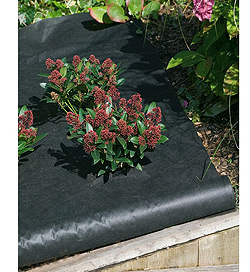 Weed
control fabric
Weed
control fabricA substantial fabric with a dense weave to prevent light getting through, allows water and nutrients to penetrate the soil. Can be cut (as an X) to allow plants to be planted through the fabric and suppress weeds nearby, best covered up with bark chips or similar to disguise the fabric once in place, requires pegging down at the edges. Also use under gravel areas, artificial lawns etc.
Mulches to suppress weeds
Organic material by preference in copious quantities will rot down and add structure and nutrients to the soil, will keep the soil from drying out so quickly retaining moisture, and will act to suppress weeds.
It's not foolproof though and weed seeds will still arrive and then just when you thought you had them on the run, will start to grow in the mulch itself. As the mulch is loose by definition, they can be very easily pulled up if they start this dirty trick. Mulches will have a significant effect on weed suppression, but the area must be cleared first, a mulch won't kill everything that's underneath it.
I am fortunate enough to have a garden large enough to be able to make lots of compost using grass and hedge clippings, fallen leaves, plants from the vegetable garden after they have done their thing etc. It's certainly worth getting some compost bins to make the most of this source of organic material. Alternatively you can buy mulch of various sorts in bags from the garden centre or much more economically in large 1 cubic metre bags from bulk suppliers. It has a limited life-span as it will rot away slowly, bark chips probably last the longest, though these too will eventually disappear. Realistically expect to replace such mulches after 3 years if not sooner, you won't need so much as you did the first time though.
Weed suppressant fabric
This is a fairly tightly woven plastic fabric which is readily permeable to water, but won't let light or weeds through. It is usually used to cover a permanently planted bed where it is started from scratch. The area is cleared and the fabric put down, anchored at the edges with pegs or pieces of bent wire at least 6" long going into the soil. X - shaped planting holes are cut in the fabric and the 4 loose triangles resulting, tucked underneath. Plants are planted through the holes. At this point the effect is of a big piece of plastic. A mulch is then applied to cover the plastic, mainly for decorative reasons, so bark-chips, gravel or the like are used rather than compost. If you use a weed suppressant fabric, then bear in mind the following:
- Organic mulches such as bark chips will rot down and blow away, so they need topping-up every 2 or 3 years.
- If you use the fabric on a slope, the mulch will gravitate to the bottom of the slope, there isn't anything you can do to hide the fabric in these circumstances.
- If people walk on the gravel or bark chip surface, then eventually the fabric will somehow become visible at various points - it always does - so use a thick layer of mulch, or better still, use a compacted hardcore base rather than the fabric.
- Gravel or stones of some kind are the most effective mulch above a fabric membrane and the surface is most effective if it is decorative only and not a path.
- Even bark chips will allow weeds to grow in them, especially as they rot and get older, so some amount of weeding is still required.
- If you have plants through the fabric, you will still get some weeds attempting to share the hole with your plants
see here for tips on how to clear large areas that have major entrenched growths of perennial weeds
Q & A
Q. We have an Oak tree in the garden. It was there when the house was built and it is about 30 feet high with a branch spread of about the same. We have allowed ivy to grow up the trunk to hide bark damage caused by the builders (a piece about 20" by 12" was ripped from the trunk). The trunk is now smothered in ivy and it is growing up into the branches. We have been told it will eventually kill the tree. Is this true?
A. Will it kill it? Maybe, maybe not, it will probably take years if not decades. Will it make it less healthy than if it were not there - certainly. Is it unsightly? to my eye - yes, maybe not to yours. Bare wood stripped of bark will stay healthier if kept open, ivy will make it damp and sheltered and allow all kinds of insects and fungi to potentially gain a foothold so accelerating the trees demise.
Copyright 2000 - present. All Rights Reserved | Privacy Policy Statement
